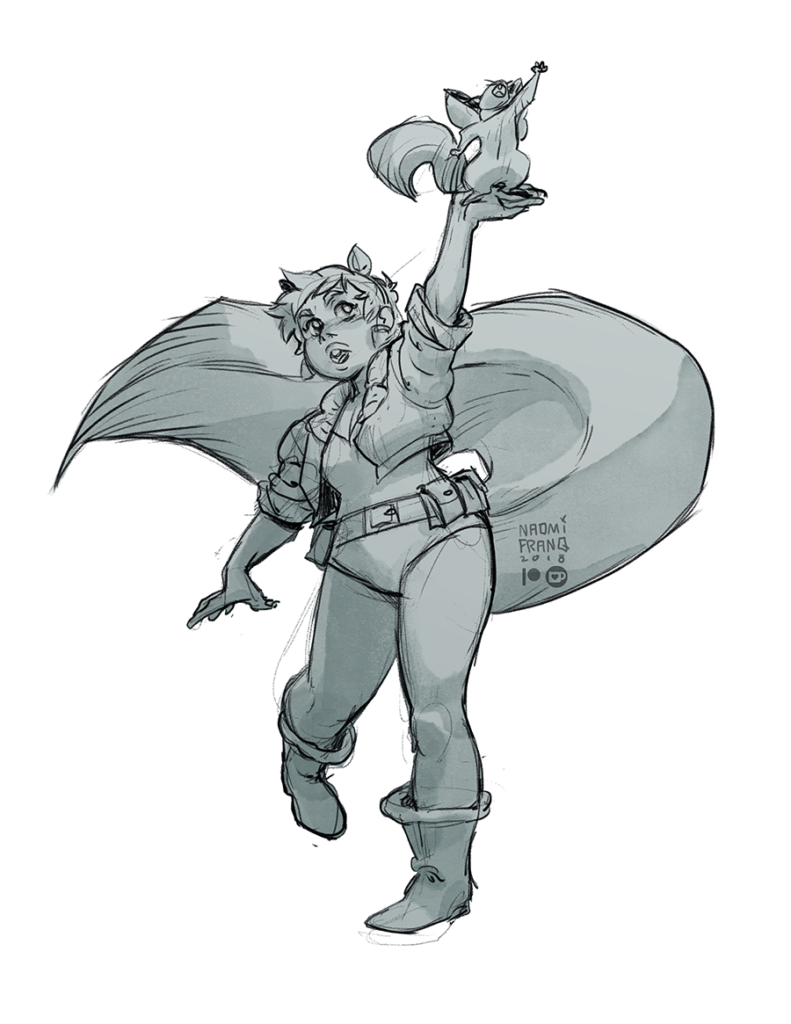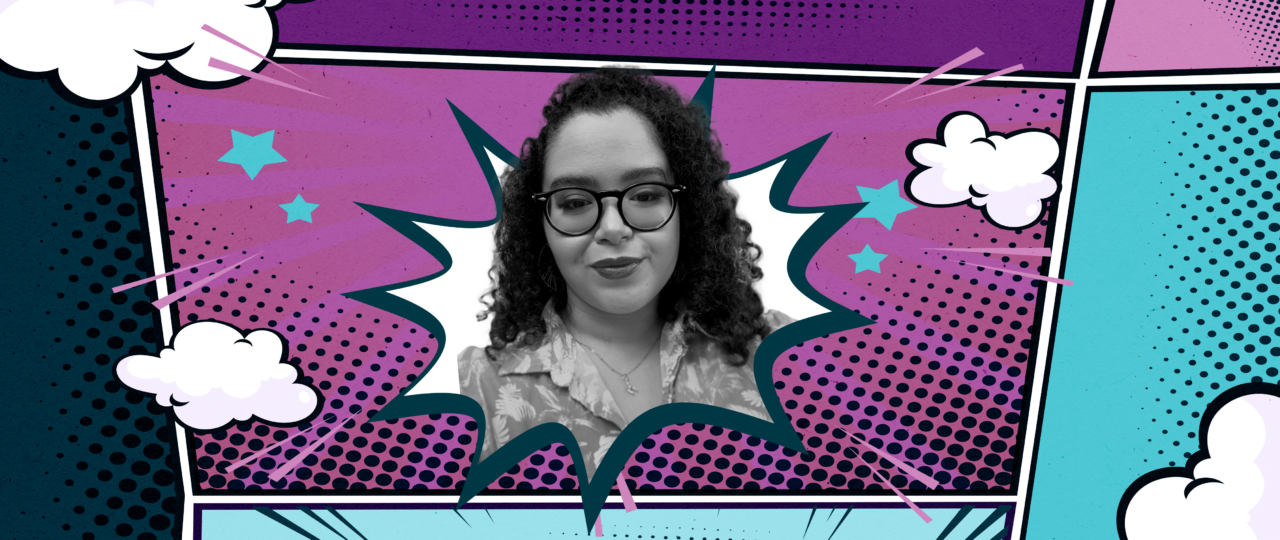When I think of how much I have to do day-in and day-out as an agency copywriter, I’m forever grateful to have a team of well-rounded, dedicated people surrounding me in every facet of ChatterBlast—from creative to strategy to analytics and beyond.
And when I think of that, it blows my mind to consider how a single person can do all of that, alone, to promote a brand. Especially when the brand is themselves.
Such is the life of a freelance artist—figuring out when to post, how much to post, where to post, and simply what to post is just another part of the job… on top of whatever creative work they’re churning out to make a living. So I spoke with my friend Naomi Franquiz, an incredibly talented, successful, full-time freelance illustrator and comic artist, to pick her brain at how she manages this monumental task, and why an active social media presence is just as important for a lone artist as it is for full-blown Marvel Universe marketing.
For people who don’t know you, tell me about yourself.
I’m Naomi Franquiz, I’m a freelance illustrator and comic book artist who has been published in works like Unbeatable Squirrel Girl (Marvel), Bitch Planet: Triple Feature (Image), Proctor Valley Road (BOOM!), multiple different publications that you’ve probably seen on the shelf.

What are some current projects you’re working on that you’re excited about?
I’m currently working on a graphic novel with a publishing company called First Second, and that’s going to be the beginning of a series of ghost stories, based off of actual ghost stories. My book is going to be Strange Mysteries, Unwanted Guests. It’s written by Steve Foxe. He’s the writer behind a lot of different titles, but most recently, I collaborated with him and the wonderful writer Che Grayson on a short story for a horror anthology magazine called Razor Blades. So if you’re into horror, I highly recommended it
I know you’ve put in a lot of work to get to where you are now as a successful, freelance, full-time illustrator. Can you walk us through how you got there?
I got my first actual comics gig, I want to say… 2017, 2016, when I got signed on to do Misfit City with BOOM! Box. That was my first monthly series. But before then, I was just kind of trying to put my work on the Internet and go through Twitter, sending hashtags and everything.
I was working a day job for about four years before I had saved up enough money and was getting enough work that I felt confident in my ability to go full-time freelance. And I mean, it worked out. Most of my references came from editors that I worked with on past comics, and they would suggest me to other editors within their publishing house, and then about a year and some change ago, I got an agent for the first time. I signed up with The Bent Agency, who was also a friend of mine and used to be my editor.
Since then they’ve been really great at getting me in contact with editors that I hadn’t already gotten to know from past projects, and that’s how I got this current book that I’m working on. So the best decision I ever made was going with my agent.

Do you have anyone else on your team that works for you? Or is it just you as a freelancer, putting your stuff out there, and then your agent helps you network, essentially?
Overall, it’s just me and my agent, Desiree, who isn’t my PR agent because they’re not doing my public relations. You know, I’m advertising myself on Twitter and Instagram. So, being a freelancer is kind of multiple jobs in one.
What social media platforms do you currently use—or, you know, used to use and don’t use so much anymore—to market yourself in your work?
Before I got more into freelance, I used to be predominantly on Tumblr, but the demographic of Tumblr kind of shifted, so it wasn’t getting the kind of professional traction that I wanted there. And then I started using Twitter and Instagram, but Twitter specifically. When I first started using it, it was helping a lot more because there were a lot of trending hashtags like #WomenInComics. #VisibleWomen is another one.
Or just like every month has a theme. You know, there’s Inktober. Or MerMay, so it’s mermaid-May: draw illustrated mermaids and use the hashtag. It was a lot easier to tap into what’s trending and get my work out that way.

I’m currently trying to shift more into Instagram. I kind of neglected it for a bit because Twitter was so easy for me without getting too time consuming. But the Twitter dynamic is shifting now that the company has changed hands and things are changing with the algorithm. So now I have to try and learn Instagram’s algorithm and try to make reels for my art. And I hate to admit it’s already working.
Reels is where it’s at, baby. So how important would you say it is to regularly update and post art on these platforms in order to stay relevant?
I mentioned before, PR and advertising itself becomes another job when you’re a freelancer. So you have to start actually scheduling administration time in your day and your workday in order to manage that because social media has a huge impact on a freelancers work—especially if you are more of an independent creator and you’re not trying to work with publishers and you’re just trying to sell original works or crafts or whatever you’re doing. Social media is a huge part. I started getting more traction in my following the more I started paying attention to trending hashtags and themes.
Do you think you’ve gotten any unique opportunities solely from your social media account that you maybe wouldn’t have gotten otherwise?
One particular unique opportunity came from the hashtag #VisibleWomen on Twitter. That hashtag was started and maintained by an in-house publishing company called Milkfed Criminal Masterminds, which is run by Kelly Sue DeConnick and Matt Fraction.
Kelly Sue was the creator behind series like Bitch Planet (along with Valentine De Landro) and also wrote for Captain Marvel, which is now a big MCU hit. So she found my Twitter and my work through that hashtag and also through word of mouth. And that became my first standalone comic—a short story in their Bitch Planet series, written by Jordan Clark. So that was my first Image publication and through them my name got introduced to other editors.
Most of the editors who emailed me found me through Twitter. If you’re not actively appearing in the algorithm, your work isn’t going to be promoted and isn’t going to be put in ‘recent’ posted works that show up in people’s feeds. So it’s very important to make sure you do that because you could be an amazing creator with amazing talent, but if nobody sees your work, it’s going to be hard to get the jobs that you want out of it.
Do you have a strategy when it comes to managing your platforms? If so, where do you go to teach yourself these things?
I’m learning a lot specifically with Instagram. I’ve been going through the reels, and a lot of people are making reels specifically about, “this sound is trending,” like, “this audio is trending or this meme is trending right now. Save this to help promote your brand or promote your Instagram page.” So a lot of people are being super helpful and showing you how to use the sound or how to spot audio that could potentially go viral.
Because a lot of times, with Instagram specifically, if you’re looking at a trending sound or meme and then you look at the source itself, the actual sound, it’ll show you how many reels have used that sound. And if it’s under a thousand, it usually has more room to grow. That tends to be the trend with Instagram: it starts off slow at first, but then it picks up.
The higher the number of uses on that sound… it becomes kind of like throwing a guppy into a tank already full of guppies. It’s already been swarmed by all these other reels, so you have less chance of getting noticed or of it really standing out. So I try to find reels that are kind of the happy middle ground: not too low a number, that’s not getting any use, but not too high that it’s a bit over-populated.
But because my shift from Twitter is quite recent, since Elon Musk bought it, I’m actively trying to figure out what my strategy is going to be on Instagram. I’ve been noticing a lot of artists using reels to promote their work, so I put one out. It was just like an “artist’s hand versus the artist’s work” to see “Does this match? Does this look like my art?” Which is kind of silly, but it’s working. It’s doing numbers.
View this post on Instagram
Do you have a ko-fi too? Is that what that’s called?
Yeah. I don’t know if it’s pronounced ko-fi or coffee. I’ve been saying coffee.
This is the first time I’ve ever said it out loud. So I don’t know.
I do have a ko-fi, or coffee. And I’m thinking about trying to open up a Patreon again. But again, it’s another job, right? So I have to really organize my time and see if I can make that happen. And if I do, I’ll probably want to keep it as casual and chill as possible so I don’t make it even more of a job because I don’t have an assistant or somebody to help manage that. I would love to one day be able to hire someone to help manage my PR. But, goals I think for me.
Keep up with Naomi and her awesome work:



